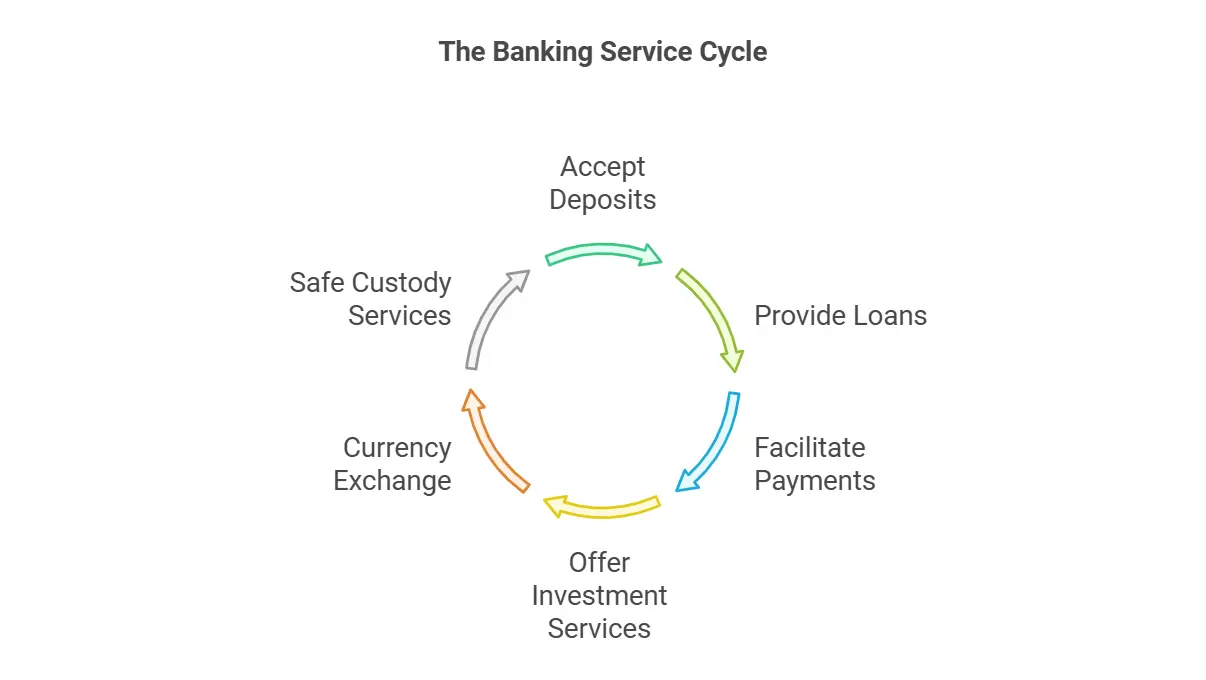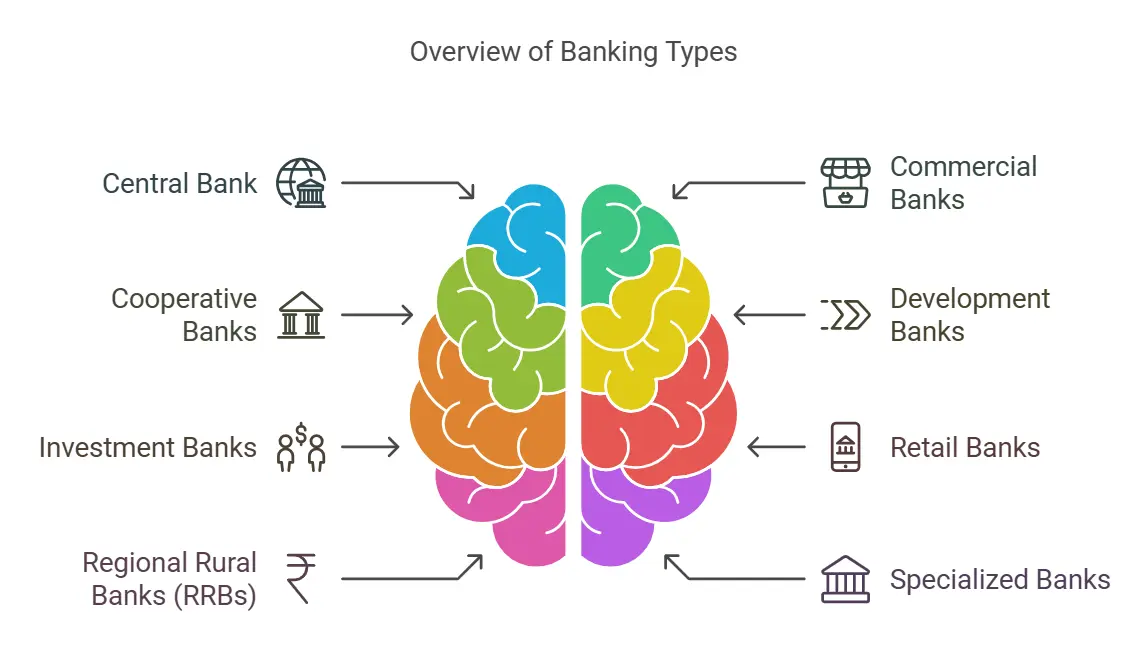Banks are financial institutions that serve as intermediaries in the economy, facilitating the flow of funds between savers and borrowers. They play a critical role in maintaining the economic stability of a country by offering financial services such as deposits, loans, investments, and payment systems. Banks are essential for both individuals and businesses, providing a safe place to store money and access credit when needed. In this article, we will explore the definition of banks, their types, examples, and key features.
What is a Bank?
A bank is a financial institution authorized to accept deposits from the public and create credit. Banks mobilize savings from individuals and organizations and lend these funds to borrowers, earning interest on loans. They act as a bridge between surplus units (savers) and deficit units (borrowers), thus contributing to economic growth.
Functions of a Bank

- Accepting Deposits: Banks accept various types of deposits, such as savings, current, and fixed deposits, from customers.
- Providing Loans: They lend money to individuals, businesses, and governments for various purposes.
- Facilitating Payments: Banks offer services such as money transfers, check clearing, and online payments.
- Investment Services: Many banks assist customers in investing in mutual funds, stocks, and bonds.
- Currency Exchange: Commercial banks provide foreign exchange services for international trade and travel.
- Safe Custody Services: Banks offer lockers to keep valuables like jewelry and important documents secure.
Types of Banks
Banks can be classified into various types based on their functions, ownership, and area of operations. Below is a detailed explanation of the major types of banks, along with examples and their features.

1. Central Bank
The central bank is the apex financial institution in a country that oversees and regulates the banking system. It is responsible for formulating monetary policy, issuing currency, and ensuring economic stability. The Reserve Bank of India (RBI) is an example of a central bank.
Features
- Sole authority to issue currency.
- Regulates and supervises other banks.
- Implements monetary policy to control inflation and money supply.
- Acts as a banker to the government and commercial banks.
- Manages foreign exchange reserves.
Example
- Reserve Bank of India (RBI) in India.
- Federal Reserve in the United States.
- Bank of England in the United Kingdom.
2. Commercial Banks
Commercial banks are financial institutions that offer a range of financial services, including deposit accounts, loans, and payment processing, primarily for profit. They cater to individuals, businesses, and government entities.
Types of Commercial Banks
- Public Sector Banks: Owned and operated by the government (e.g., State Bank of India, Punjab National Bank).
- Private Sector Banks: Owned by private entities (e.g., HDFC Bank, ICICI Bank).
- Foreign Banks: Operate in a country but are headquartered abroad (e.g., Citibank, HSBC).
Features
- Accepts deposits and provides loans.
- Facilitates payment systems (e.g., checks, NEFT, RTGS).
- Offers investment and insurance products.
- Focused on profit-making through interest and fees.
Examples
- Public Sector: State Bank of India (SBI), Bank of Baroda.
- Private Sector: Kotak Mahindra Bank, Axis Bank.
- Foreign Banks: Standard Chartered Bank, Deutsche Bank.
3. Cooperative Banks
Cooperative banks are financial institutions owned and operated by their members, who are also customers. These banks aim to provide affordable financial services, especially in rural areas.
Features
- Operate on the principles of mutual help and cooperation.
- Provide credit at lower interest rates compared to commercial banks.
- Cater to agricultural and rural sectors.
- Owned and managed by members with voting rights.
Examples
- Urban Cooperative Banks: Saraswat Bank, Cosmos Bank.
- Rural Cooperative Banks: Primary Agricultural Credit Societies (PACS), State Cooperative Banks.
4. Development Banks
Development banks are specialized financial institutions established to provide long-term capital for industrial, agricultural, and infrastructure development. They primarily support large-scale projects that require significant investment.
Features
- Focused on long-term financing.
- Provide technical and financial assistance to industries.
- Promote regional and sectoral development.
- Often supported by the government.
Examples
- Industrial Development Bank of India (IDBI).
- National Bank for Agriculture and Rural Development (NABARD).
- Export-Import Bank of India (EXIM Bank).
5. Investment Banks
Investment banks specialize in providing financial services related to raising capital, mergers and acquisitions (M&A), and wealth management. They do not accept deposits but cater to high-net-worth individuals, corporations, and governments.
Features
- Assist in raising capital through stock or bond issuance.
- Provide advisory services for mergers and acquisitions.
- Offer wealth management and trading services.
- Focused on high-value financial transactions.
Examples
- Goldman Sachs.
- Morgan Stanley.
- JP Morgan Chase.
6. Retail Banks
Retail banks focus on providing financial services to individual customers. These include savings accounts, personal loans, credit cards, and home loans.
Features
- Caters to individual needs.
- Provides personalized financial products and services.
- Offers both physical branches and digital banking platforms.
Examples
- ICICI Bank (Retail Division).
- HDFC Bank.
- Citibank (Retail Division).
7. Regional Rural Banks (RRBs)
Regional Rural Banks are government-supported financial institutions that serve rural areas by providing credit and other financial services to farmers, small businesses, and rural communities.
Features
- Focus on rural development and financial inclusion.
- Provide affordable loans to farmers and rural entrepreneurs.
- Jointly owned by the central government, state government, and sponsoring banks.
Examples
- Prathama Bank.
- Karnataka Gramin Bank.
- Andhra Pradesh Grameena Vikas Bank.
8. Specialized Banks
Specialized banks are financial institutions that focus on specific sectors or activities, such as export-import financing, housing finance, or small business development.
Features
- Tailored to meet the needs of specific sectors.
- Offer financial and advisory services.
- Often supported by the government or industry associations.
Examples
- Export-Import Bank of India (EXIM Bank) for international trade.
- National Housing Bank (NHB) for housing finance.
9. Internet-Only Banks (Digital Banks)
Internet-only banks, or digital banks, operate entirely online without physical branches. They provide financial services through mobile apps and websites.
Features
- Operate with lower operational costs due to the absence of physical branches.
- Offer higher interest rates on deposits and lower fees.
- Focused on convenience and 24/7 accessibility.
Examples
- Paytm Payments Bank.
- Niyo Bank.
- Digibank by DBS.
Comparison of Types of Banks
| Type of Bank | Primary Focus | Key Features | Examples |
|---|---|---|---|
| Central Bank | Monetary policy and regulation | Currency issuance, banking system oversight | RBI, Federal Reserve |
| Commercial Bank | Profit-making financial services | Deposits, loans, payments | SBI, HDFC Bank, Citibank |
| Cooperative Bank | Mutual benefit for members | Low-cost credit, rural focus | Saraswat Bank, PACS |
| Development Bank | Long-term capital for projects | Industrial, agricultural, and infrastructure | NABARD, IDBI |
| Investment Bank | Capital markets and advisory | Mergers, acquisitions, wealth management | Goldman Sachs, Morgan Stanley |
| Retail Bank | Individual customers | Savings accounts, personal loans | ICICI Bank, HDFC Bank |
| Regional Rural Bank | Rural financial inclusion | Loans to farmers and rural businesses | Prathama Bank, Karnataka Gramin Bank |
| Specialized Bank | Sector-specific services | Export finance, housing finance | EXIM Bank, NHB |
| Internet-Only Bank | Digital financial services | Online banking, low-cost operations | Paytm Payments Bank, Niyo Bank |
For More Content Check Out :- KMBN 302
Conclusion
Banks are vital to the economic development of any country, serving as facilitators of savings, investments, and credit. Each type of bank has unique features designed to cater to specific financial needs, whether it’s a central bank ensuring monetary stability, a commercial bank serving businesses, or a cooperative bank promoting rural development. Understanding these types and their functions allows individuals and businesses to make informed financial decisions, leveraging the right banking services for their specific needs.

